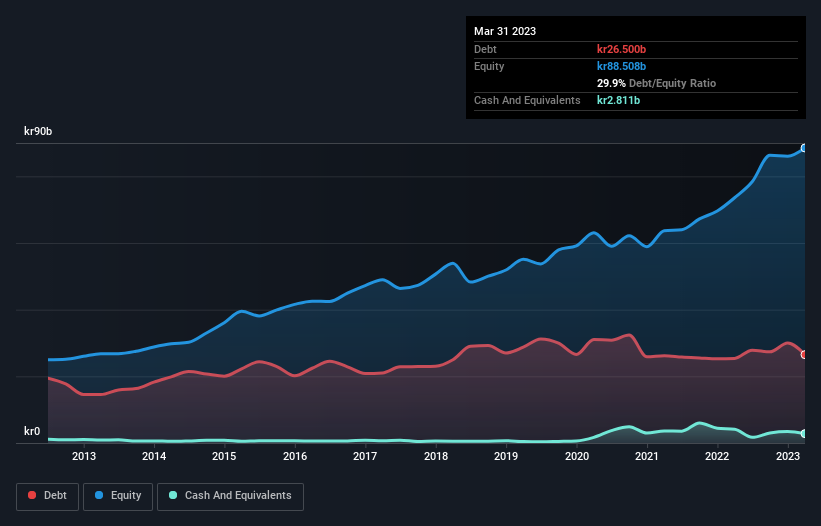
Warren Buffett famously said, 'Volatility is far from synonymous with risk.' So it might be obvious that you need to consider debt, when you think about how risky any given stock is, because too much debt can sink a company. We note that ASSA ABLOY AB (publ) (STO:ASSA B) does have debt on its balance sheet. But should shareholders be worried about its use of debt?
Why Does Debt Bring Risk?
Debt assists a business until the business has trouble paying it off, either with new capital or with free cash flow. If things get really bad, the lenders can take control of the business. While that is not too common, we often do see indebted companies permanently diluting shareholders because lenders force them to raise capital at a distressed price. Of course, debt can be an important tool in businesses, particularly capital heavy businesses. When we examine debt levels, we first consider both cash and debt levels, together.
See our latest analysis for ASSA ABLOY
How Much Debt Does ASSA ABLOY Carry?
You can click the graphic below for the historical numbers, but it shows that as of March 2023 ASSA ABLOY had kr26.5b of debt, an increase on kr25.4b, over one year. However, because it has a cash reserve of kr2.81b, its net debt is less, at about kr23.7b.

How Healthy Is ASSA ABLOY's Balance Sheet?
The latest balance sheet data shows that ASSA ABLOY had liabilities of kr37.3b due within a year, and liabilities of kr29.1b falling due after that. Offsetting these obligations, it had cash of kr2.81b as well as receivables valued at kr25.8b due within 12 months. So its liabilities outweigh the sum of its cash and (near-term) receivables by kr37.8b.
Given ASSA ABLOY has a humongous market capitalization of kr268.3b, it's hard to believe these liabilities pose much threat. Having said that, it's clear that we should continue to monitor its balance sheet, lest it change for the worse.
We measure a company's debt load relative to its earnings power by looking at its net debt divided by its earnings before interest, tax, depreciation, and amortization (EBITDA) and by calculating how easily its earnings before interest and tax (EBIT) cover its interest expense (interest cover). The advantage of this approach is that we take into account both the absolute quantum of debt (with net debt to EBITDA) and the actual interest expenses associated with that debt (with its interest cover ratio).
ASSA ABLOY's net debt is only 1.1 times its EBITDA. And its EBIT covers its interest expense a whopping 18.0 times over. So we're pretty relaxed about its super-conservative use of debt. Also positive, ASSA ABLOY grew its EBIT by 24% in the last year, and that should make it easier to pay down debt, going forward. When analysing debt levels, the balance sheet is the obvious place to start. But ultimately the future profitability of the business will decide if ASSA ABLOY can strengthen its balance sheet over time. So if you want to see what the professionals think, you might find this free report on analyst profit forecasts to be interesting.
Finally, a company can only pay off debt with cold hard cash, not accounting profits. So it's worth checking how much of that EBIT is backed by free cash flow. During the last three years, ASSA ABLOY generated free cash flow amounting to a very robust 84% of its EBIT, more than we'd expect. That positions it well to pay down debt if desirable to do so.
Our View
ASSA ABLOY's interest cover suggests it can handle its debt as easily as Cristiano Ronaldo could score a goal against an under 14's goalkeeper. And that's just the beginning of the good news since its conversion of EBIT to free cash flow is also very heartening. Considering this range of factors, it seems to us that ASSA ABLOY is quite prudent with its debt, and the risks seem well managed. So the balance sheet looks pretty healthy, to us. We'd be very excited to see if ASSA ABLOY insiders have been snapping up shares. If you are too, then click on this link right now to take a (free) peek at our list of reported insider transactions.
When all is said and done, sometimes its easier to focus on companies that don't even need debt. Readers can access a list of growth stocks with zero net debt 100% free, right now.
New: Manage All Your Stock Portfolios in One Place
We've created the ultimate portfolio companion for stock investors, and it's free.
• Connect an unlimited number of Portfolios and see your total in one currency
• Be alerted to new Warning Signs or Risks via email or mobile
• Track the Fair Value of your stocks
Have feedback on this article? Concerned about the content? Get in touch with us directly. Alternatively, email editorial-team (at) simplywallst.com.
This article by Simply Wall St is general in nature. We provide commentary based on historical data and analyst forecasts only using an unbiased methodology and our articles are not intended to be financial advice. It does not constitute a recommendation to buy or sell any stock, and does not take account of your objectives, or your financial situation. We aim to bring you long-term focused analysis driven by fundamental data. Note that our analysis may not factor in the latest price-sensitive company announcements or qualitative material. Simply Wall St has no position in any stocks mentioned.
About OM:ASSA B
ASSA ABLOY
Provides door opening and access products for the institutional, commercial, and residential markets.
Undervalued with solid track record and pays a dividend.
Similar Companies
Market Insights
Community Narratives



